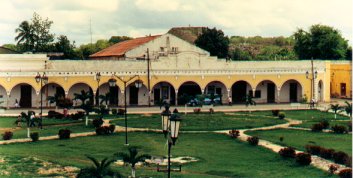Izamal
|
|
Izamal is a small city in Yucatán state, Mexico, 72 km (about 40 miles) East of Mérida, Yucatán, at Template:Coor dm. Izamal has been continuously occupied for thousands of years. Population estimated at 15,000 people in 2000. It is known in Yucatan as "The Yellow City" (for customarily most of its buildings are painted that color) and "The City of Hills" (though most of the "hills" are probably the remains of ancient temple pyramids).
Izamal was an important site of the Pre-Columbian Maya civilization. It was sacred to the creator deity Itzamna and to the Sun God Kinich Ahau. Izamal was a site of pilgrimage in the region rivaled only by Chichen Itza.
Two huge Pre-Columbian structures are still easily visible at Izamal (and from some distance away in all directions). The first is a great pyramid to the Maya Sun God, Kinch Kak Mo, with a base covering over 2 acres (8,000 m²) of ground and a volume of some 700,000 cubic meters. Atop this grand base is a pyramid of 10 levels. (A great stucco mask still existed on one side as recently as the 1840s, and a drawing of it by Frederick Catherwood was published by John Lloyd Stephens.) The second structure is the so called "acropolis", known anciently as Popol Chac, a large man-made mound probably built up over several centuries and originally supporting city palaces and temples. After the Spanish conquest of Yucatán in the 16th century a Spanish colonial city was founded atop the existing Maya one, however it was decided that it would take a prohibitively large amount of work to level these two huge structures and so the Spanish contented themselves with placing a small Christian temple atop the great pyramid and building a large Franciscan Monastery atop the acropolis. It was named after San Antonio de Padua. Completed in 1561, the atrium of the Monastery was second in size only to that at the Vatican. Much of the cut stone from the Pre-Columbian city was reused to build the Spanish churches, monastery, and surrounding buildings.
Izamal remains a place of pilgrimage within Yucatán, now for the veneration of Roman Catholic saints. Several saints statues at Izamal are said to perform miracles. An early colonial era statue of the Virgin of the Immaculate Conception is particularly venerated, and is the city's patron saint.
| Contents |
History
Little archeological work has been done at Izamal, but it is known that it was already an important city by the start of the Classic era about 200 AD, and over 80 archaeologically important structures have been mapped here.
Izamal was the first chair of the Bishops of Yucatán before they were moved to Merida. The forth Bishop of Yucatán, Diego de Landa lived here.
The town of Izamal was first granted the status of city by the government of Yucatán on 4 December, 1841. On 13 August, 1923 it was demoted to town status. It was again officially ranked as a city on 1 December, 1981.
In 1975 the Mexican official in charge of land redistribution was repeatedly accused of political corruption; letters of complaint were sent from citizens of Izamal to Mérida and Mexico City with no response. The official was found stoned to death under a large pile of rocks in the town's main square. A Mexican army unit occupied the town for some days after the incident, but investigators failed to find anyone in town who knew anything about what happened.
Pope John Paul II visited Izamal in August 1993, where he performed a mass for the Native Americans and presented the statue of the Virgin with a silver crown.
Izamal today
The Maya language is still heard at least as much as Spanish in Izamal. It is the first language in the homes of the majority of the people. Most signs are in both languages.
Major Fiestas are held in Izamal on April 3, May 3, August 15, and December 8.
Photos
Missing image
IzamalConventSmall.jpg
Image:IzamalConventSmall.jpg
Convent as viewed from atop Kinich Kak Mo pyramid
larger photo

Arcade with pyramid in background
larger photo
External link
- Izamal's monastery on colonial-mexico.com (http://www.colonial-mexico.com/Yucatan/izamal.htm) with photos and a map of the center of town
- Izamal on yucatantoday.com (http://www.yucatantoday.com/destinations/eng-izamal.htm)fr:Izamal


